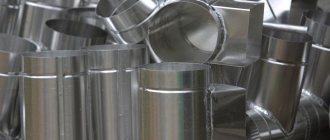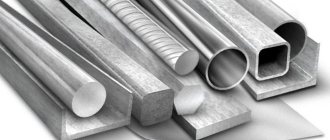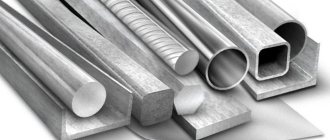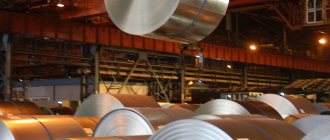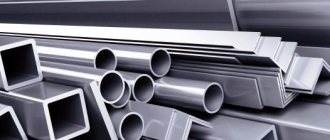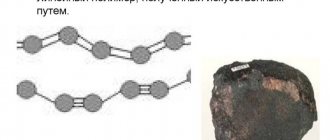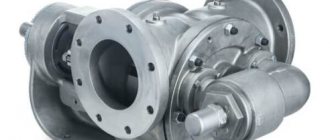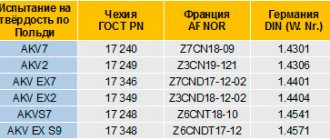01/18/2022 Author: VT-METALL
From this material you will learn
:
- Characteristics of corrosion-resistant steel
- 4 types of corrosion-resistant steel
- Marking and application of corrosion-resistant steel
- Foreign grades of corrosion-resistant steels
- Nuances of welding corrosion-resistant steels
Corrosion-resistant steel (aka stainless steel)
has firmly entered our lives and is used in various fields: from the chemical and aviation industries to the manufacture of everyday goods. The thing is that this type of steel shows much better characteristics than regular steel, and the variety of grades allows you to select the material that best suits your needs.
The history of this material goes back more than a century, and the number of brands exceeds two hundred, so it is important to understand their characteristics when choosing stainless steel as a material for your needs. In our article we will tell you what characteristics corrosion-resistant steel has, what types it is divided into, and also talk about the nuances of Western and domestic markings.
Characteristics of corrosion-resistant steel
Corrosion-resistant steel, an invention of metallurgist Harry Brearley, was patented in 1913 in England. Thanks to this material, steel and other industries have reached a completely new level.
Conventional steel alloys acquired unique properties and were able to resist the formation of rust due to the addition of chromium to their composition. For corrosion-resistant steels and alloys, the content of this element must be at least 10.5%. In this way the following characteristics are achieved:
- very high resistance to corrosion;
- excellent strength;
- good weldability;
- ease of processing using cold deformation;
- long service life, during which the material retains its original qualities;
- attractive appearance of products.
The essential components of corrosion-resistant steels are chromium and iron. Due to the fact that these additives complement each other, the material acquires unique characteristics. Chromium combines with oxygen and forms an oxide film on the surface of the alloy - it is this film that prevents the formation of rust.
VT-metall offers services:
However, the described properties of stainless steel can be further improved with the help of alloying additives, such as nickel, titanium, molybdenum, niobium, cobalt, etc. Thanks to alloying, many types of stainless steel alloys are created in production, which have different characteristics and purposes.
The carbon contained in corrosion-resistant steel provides the metal with high hardness and strength. In addition, this element is included in all steel alloys, since many significant properties depend on it.
Stainless steel has a number of unique qualities, so it is actively used in areas where the product or equipment must constantly operate under high humidity and exposure to aggressive environments. Corrosion-resistant steels are used to make objects for use in industry and even in everyday life - this metal is the material of cutlery, knives, communication elements, enclosing structures, equipment parts, etc.
Chemical composition
The chemical composition of stainless steel depends on the type and grade of the alloy. The main features that characterize stainless steel are the presence of at least 10.5% chromium and low carbon content. Carbon is very important in steel making as it gives the required strength. The percentage component of which in the anti-corrosion alloy should not exceed 1.2%.
Stainless steel may also contain Titanium, Phosphorus, Molybdenum, Sulfur, Nickel and Niobium. Depending on the chemical composition, stainless steel is divided into several types.
The most widely used is stainless steel of group A2. Group A2 contains 10% nickel, 18% chromium and 0.05% carbon. Most of it is occupied by the base, namely iron with accompanying components.
The composition of steels in this group includes 0.05% carbon, 2% molybdenum, 12% nickel and 17% chromium. Due to the presence of molybdenum in the composition, the alloy is resistant to acid, so the name “acid-resistant” is often applied to it.
Anti-corrosion steels of group A, due to their chemical composition, are easy to weld. That is why this type is widely used in industry. From such steel it is possible to produce parts of almost any shape, with a strong connection of the component parts.
Particular attention in production is paid to steel for the food industry. In this case, corrosion-resistant steel should not contain foreign components that can negatively affect the taste of products, as well as impurities hazardous to human health.
The resistance of steel to corrosion depends on the amount of chromium. The larger its component, the more stable the alloy. Classic stainless steel used under normal conditions contains no more than 13% chromium. To withstand an aggressive environment, the proportion of chromium must exceed 17%. This corrosion-resistant alloy is suitable for use in acidic environments.
Highly resistant alloys retain their properties even in nitric acid of 50% saturation. For resistance against stronger acids, the percentage of nickel in the composition is increased and other components are added in small quantities.
Read also: Shut-off control and safety valves
Marking and application of corrosion-resistant steel
Today there are more than 50 grades of corrosion-resistant chromium-nickel steels. They are used as a material for pipe and flat products, fittings, channels, beams, angles, and profiles. In addition, stainless steel is actively used in the automotive, aircraft, and energy industries.
Austenites are used to produce products by welding and cold stamping, such as:
- construction tanks;
- pipes;
- installations for oil rigs, cleaning systems;
- turbines and other mechanisms that must function in water;
- power units for the energy sector;
- aircraft and car parts;
- equipment for working with food products;
- pharmacological and medical technology;
- welded metal structures;
- hardware.
In accordance with GOST, such alloys are marked
:
- 12Х18Н10Т
. Includes nickel, titanium, and is a material for equipment for the chemical and oil refining industries. - 12Х18Н10Т
. Used in the production of pipelines. - 12X15G9ND
. It contains nickel, manganese and copper and is used for the manufacture of containers and pipelines for solutions with moderate aggressiveness.
Martensites are used in the production of products for work in aggressive environments under conditions of low or medium intensity. Elasticity makes it possible to make springs, flanges, and shafts from such corrosion-resistant steel. In addition, metal is a material for cutting surfaces in the food and chemical industries.
Grades of martensitic steels
:
- 20Х13, 30Х13
. Used in the manufacture of household appliances. - 14Х17Н2
. Contains nickel and can be used for the production of compressors and other equipment that is planned to be operated at low temperatures and in aggressive environments.
Ferrites are found in the following areas:
- chemical and petrochemical industry;
- energy;
- heavy engineering and machine tools;
- instrument making;
- medical equipment;
- production of household appliances;
- food industry.
We are talking about the following types of corrosion-resistant steels
:
- 08X13
. Suitable for making kitchen appliances. - 12X13
. Used to create containers intended for storing and transporting alcohol-containing liquids. - 12X17
. This is a corrosion-resistant and heat-resistant steel, in tanks from which food is processed at high temperatures.
Stainless steel standards
There are state standards for different types of stainless steel in our country. They determine the quality of products made from this material. Stainless steel has different GOST standards. Certain quality standards are developed for thin sheets, for wire, for thick sheets and for stainless steel pipes.
Stainless steel has different characteristics. Thanks to its chemical and physical parameters, it easily resists the formation of corrosion plaque. This material was developed for use in places where there are different environmental conditions. Due to its heat resistance and strength, steel does not react with substances in the environment.
Foreign grades of corrosion-resistant steels
Steel grades AISI 201 and AISI 202 belong to the austenitic group of alloys.
It is worth clarifying that the abbreviation stands for American Iron and Steel Institute or “American Institute of Steel and Alloys.” These metals contain chromium, nickel, manganese, copper, nitrogen, due to which high strength of the products is achieved. The material also lends itself well to deformation and easily changes shape.
The balanced composition of these corrosion-resistant steels allows them to stand out from the crowd with their high resistance to rust.
AISI 201 and AISI 202 are used for the production of household appliances, pipelines, and building structures.
The difference between these brands is the content of additional components. AISI 201 contains more carbon, sulfur, manganese and copper, which provides high strength and ductility. While AISI 202 contains more nickel. It should be noted that AISI 201 is an improved version of AISI 202, but both brands retain their physical characteristics even when products made from them are used in a moderately aggressive environment.
There are Russian analogues of these corrosion-resistant steels:
- AISI 201 can be replaced with 12X15G9ND;
- AISI 202 is close to 12X17G9AN4.
Steel grades of the 300 series are included in the chemical composition of the austenitic or duplex group of alloys. The type of stainless steel depends on the proportion of basic additives, such as carbon, nickel, chromium, titanium. It is important that this series is considered universal and popular in the market, as it has high strength, resistance to wear and rust.
Decoding stamps
The marking of alloy steels consists of letters and numbers. At the beginning there is a two-digit number that characterizes the amount of carbon in hundredths of a percent. The following are letters of the Russian alphabet, denoting a specific element:
- X – chromium;
- N – nickel,
- T – titanium;
- B – tungsten;
- G – manganese;
- M – molybdenum;
- D – copper.
After the letter designation of the alloying element in the decoding there is a number indicating its content in stainless steel, rounded to the nearest whole percent. If there is no such figure, then the additive in the alloy is in the range of 1-1.5%.
Nuances of welding corrosion-resistant steels
Corrosion-resistant steel has such qualities as heat resistance up to +650 °C and heat resistance within +480...+500 °C. Such alloys are characterized by low thermal conductivity, which is why structures made from them are often subject to distortion and warping. Whereas the oxidation of chromium leads to the formation of refractory slag, which interferes with welding.
To weld chromium stainless steels, mild thermal conditions are chosen, which implies low current density, direct current of reverse polarity, that is, the plus is attached to the electrode. It is also important to ensure a low cooling rate, in other words, it is important to avoid drafts during operation.
Corrosion-resistant steel is welded using electrodes with calcium fluoride coatings
.
Martensites and alloys belonging to the martensitic-ferritic class require hardening in the welding zone under normal conditions. You need to understand that there is a high probability of cracks appearing here, especially when it comes to thick-walled and rigid structures.
Recommended articles
- Types of metal corrosion: classification, methods of protection
- Protection of metal structures from corrosion and fire
- Metal hardening: technology and choice of temperature conditions
It is possible to improve the quality of welding by local heating to +200...+300 °C of products with a thickness of over 8–10 mm. However, the upper limit of heating and the time of holding this temperature are limited, since fragility or blue brittleness may appear. After welding, the joint area has increased hardness, therefore, after a certain time, the finished object is tempered to +700...+760 °C, due to which the restoration of resistance to intergranular corrosion is achieved.
When choosing corrosion-resistant steel, it is important to understand the further conditions of its operation, the load that the metal will experience, and additional properties of the product. If you have any doubts, it is recommended to seek professional advice.
